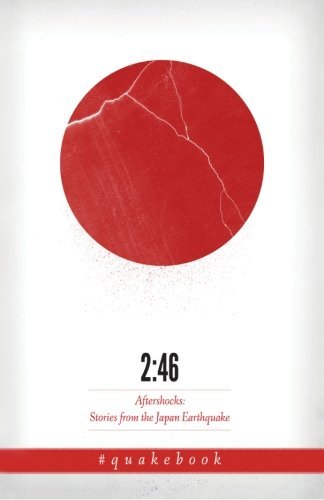2:46 Aftershocks : Stories from the Japan Earthquake (Enhanced Editions Ltd.)
Next month is the twenty-first anniversary of the Great East Japan Earthquake, commonly referred to as 3-11. On March 11, 2011 at 2:46pm, a massive earthquake that registered 9.0-9.1 magnitude hit the Tohoku area of Japan. It was the most powerful quake to hit Japan and triggered a tsunami that reached a height of over one-hundred feet (over forty meters) which washed away people and their homes. The tsunami caused the disaster at the Fukushima Nuclear Power Plant as well.
2:46 Aftershocks was recorded, written and published in just over a week after the disaster. It was the brainchild of a man living in Abiko, Chiba Prefecture. The man who calls himself Our Man in Abiko explains, “The idea for this book came out of desperation; desperation to do something for a country on its knees.”
On the morning of March 18, 2011, one week after the quake, Our Man in Abiko wrote to @fatblueman, a group who became popular for their song “Christmas in Japan” on YouTube, to start writing a song for Japan quake survivors. It was this Tweet which got him thinking, “I want to compile a book of quake experiences and publish it like within a week and donate all profits to Red Cross.”
Our Man in Abiko created a Twitter account with the #quakebook hashtag and tweeted, “If everyone wrote 250 words - one page - or submitted their favorite (original) tweets, pics or artworks, I could edit, publish it in days.”
People from all over the world contributed pictures, stories, illustrations, prayers, and words of hope to unite the world in helping Japan get back on its feet. Many of the stories were written by the people who were there, living and experiencing one of the world’s worst disasters. A couple of celebrities donated their time and gave support to the project including Yoko Ono and cyberpunk author William Gibson.
The Foreword to the book was written by Barry Eisler, the creator of a half-Japanese, half-American assassin named John Rain. Eisler says, “If my books have been love letters to Japan, this one is an SOS. I’m both proud and humbled to be a part of it, to be in a position to reach others who love Japan and long for Japan so that together we can give back some of what we received, and to do something to help Japan back to her feet.”
American journalist and Japanophile Jake Adelstein rewrote an article titled Muenbotoke, a term that literally translates to ‘Buddhas without connections’. The piece was originally published in the magazine Shambhala Sun. He related the story of a double-suicide of a couple whose bodies were never claimed by anybody. This made him think of the bodies that were never recovered from the tsunami. Adelstein ends his article with “May their memories last longer than the accident that took their lives. Because remembering them is all we can do for them now and for all those who lost their lives. And in the act of remembering, hopefully we will lead better lives and remember to care for all living things. We owe the dead that much.”
According to a press release on March 9, 2021, twenty years after the quake, the official figures reported 19,747 deaths, 6,242 injured, and 2,556 people still missing. Anybody who was living in Japan at the time knows exactly where they were and what they were doing. I was living in Tokyo at the time of the disaster as well. I had taken the day off from work and was sitting on the couch with my wife. She was watching television while I was on the phone with my parents who live in the States. The room started shaking but we didn’t give it much notice as we have been through the routine many times before. But this time, the shaking wouldn’t stop and was getting stronger as well. I had to cut my call quickly as my wife and I headed out the door of our fourth floor apartment. It is definitely not an experience I wish to relive. I currently live in the Tohoku area and hope and believe that I am also contributing to its recovery. ~Ernie Hoyt
